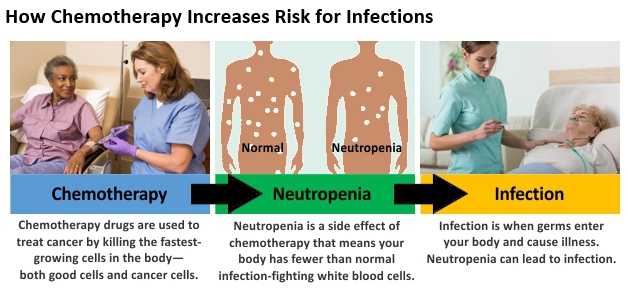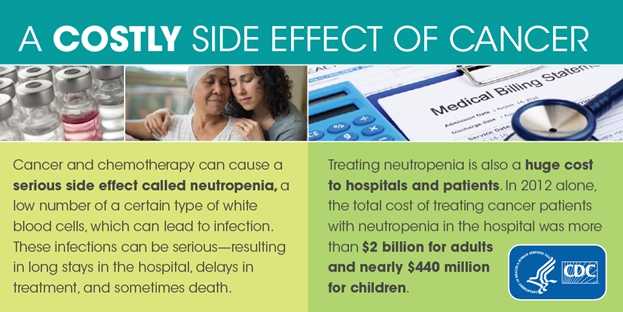Cost of Cancer-Related Neutropenia or Fever Hospitalizations
Chemotherapy can cause neutropenia, which can lead to infections.
Cancer patients are often treated with chemotherapy. These powerful cancer-fighting drugs work by killing the fastest-growing cells in the body—both good and bad. So chemotherapy often kills healthy white blood cells as well as cancer cells. Having fewer than normal white blood cells is a condition called neutropenia.
White blood cells are the body’s main defense against infection. An infection occurs when germs enter a person’s body and multiply, causing illness. Having neutropenia makes it harder for the body to fight infections, so cancer patients who receive chemotherapy have a higher risk of getting a serious infection.

Scientists wanted to know how many cancer patients in the United States get serious infections because of neutropenia each year. So they looked at the latest data from the largest all-payer inpatient database in the United States (the 2012 National Inpatient Sample and Kids’ Inpatient Database) to see how many cancer patients were hospitalized with either neutropenia or a fever (a fever may be the only sign of an infection).
Key Findings
In the United States in 2012—
- 91,560 adults and 16,859 children with cancer were treated at a hospital because of neutropenia.
- The total cost for adults being hospitalized for cancer-related neutropenia was $2.3 billion, and $439 million for children. That was about 8% of all cancer-related hospital costs for adults ($27.5 billion) and 27% of all cancer-related hospital costs for children ($1.6 billion).
- On average, adult cancer patients who were treated at a hospital because of neutropenia stayed about three days longer and paid about $5,700 more than adult cancer patients who went to the hospital for other reasons.
- Children with cancer who were treated at a hospital because of neutropenia stayed about a day longer on average and paid about $1,750 less than children with cancer who went to the hospital for other reasons.
- Leukemia was the most common kind of cancer among both adults and children who were treated at a hospital because of neutropenia.
- Both adult and child cancer patients who were treated at a hospital for neutropenia were more likely to be admitted through the hospital’s emergency room than cancer patients who were treated at a hospital for other reasons.
What Can Be Done
Infections that are linked to neutropenia are some of the most serious side effects of chemotherapy. Earlier studies found that each year in the United States, 60,000 cancer patients are hospitalized with neutropenia and 4,000 die of neutropenia with fever.
It’s cheaper and easier to prevent infections than to treat them. Most cancer patients go to a health care clinic often during their treatment, where they can be exposed to infections. These facilities must take great care to stop infections from spreading from one patient to others. CDC’s Basic Infection Control and Prevention Plan for Outpatient Oncology Settings provides guidelines.
Cancer patients can learn about their risk of getting neutropenia and an infection during treatment and get tips on how to prevent infections on the 3 Steps Toward Preventing Infections During Cancer Treatment website.
Citation
Tai E, Guy GP, Dunbar A, Richardson LC. Cost of cancer-related neutropenia or fever hospitalizations, United States, 2012. Journal of Oncology Practice 2017;13(6):e552–e561.
Image to Share

- Page last reviewed: September 5, 2017
- Page last updated: September 5, 2017
- Content source:
- Maintained By:


 ShareCompartir
ShareCompartir